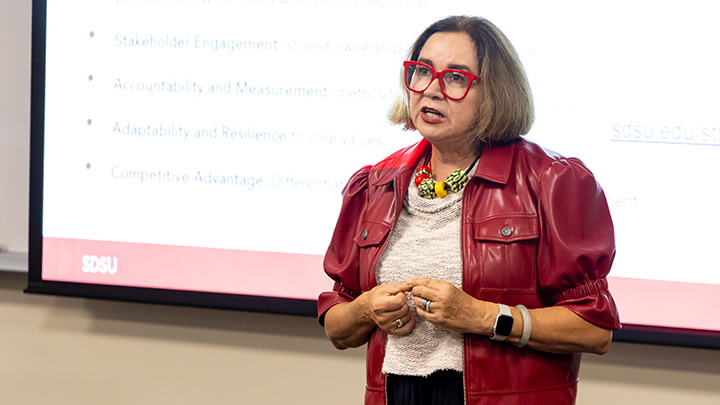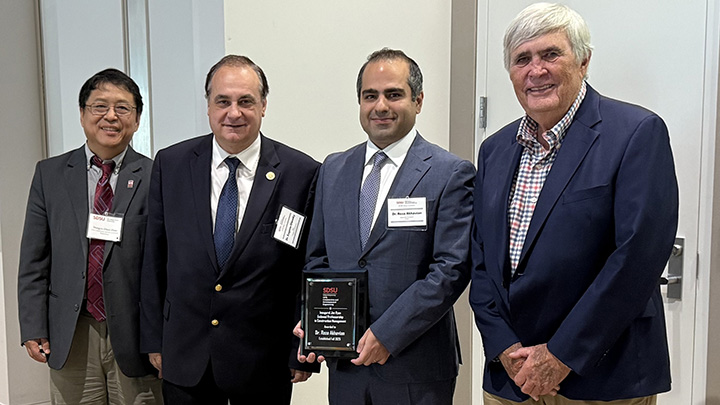Leadership meets learning: President de la Torre’s return to the classroom
For the first time in eight years, the president returned to her roots as a decorated professor to teach a graduate course on leadership in higher education.

After more than eight years away from teaching, San Diego State University President Adela de la Torre returned to the classroom this fall — and rediscovered one of her greatest joys.
De la Torre built a four-decade career as a professor and researcher long before becoming an administrator at the University of California, Davis in 2012 and SDSU’s president in 2018. This fall, she taught Strategic Leadership in Higher Education, a seminar for doctoral students in the College of Education.
The decision, she said, grew out of an informal lunch with graduate students last year at SDSU’s Faculty-Staff Club. It reminded her how much she valued mentoring the next generation of educational leaders.
“They were curious about my path to becoming a president,” de la Torre recalled. “I realized how much I enjoyed that conversation and how valuable it could be to share the lessons I’ve learned with students whose hearts are in higher education and aspire to lead.”
That conversation led to a semester-long course built around real-world leadership and the evolving challenges facing public higher education. Her class of about 20 graduate students ― all currently working in K-12 and higher education ― explored topics including shared governance, budgeting, communications, policy and the growing influence of artificial intelligence.
Students said the opportunity to learn directly from SDSU’s president offered a rare, behind-the-scenes perspective on leadership in higher education from someone whose credibility comes from very tangible success.
“Each week in President de la Torre's class was like a master class in strategic leadership,” said Yvonne Tempel, a student in the Doctor of Education in Educational Leadership program who also is the executive assistant to SDSU’s vice president for Information Technology and Chief Information Officer. “It was powerful knowing that the knowledge, information and experience she shared went beyond theory and came from her practical experience working at the highest levels as a professor and administrator.”
SDSU growth
Another Doctor of Education student in the Educational Leadership program, SDSU Chief Information Security Officer Ricardo Fitipaldi, said the course offered a firsthand look at the kind of intentional leadership shaping SDSU’s rise on the national stage.
“SDSU’s growth isn’t accidental; it reflects the clarity and discipline President de la Torre brings to decisions,” he said. “Experiencing that approach firsthand in her class made strategy feel tangible and urgent.”
To enrich the experience, de la Torre invited guest speakers, including a lesson on budgeting from SDSU’s chief financial officer and a class on shared governance from the chair of the University Senate. Students collaborated on policy briefs and short presentations modeled on the concise communications expected of senior administrators.
“At a leadership level, brevity and clarity are key,” de la Torre explained. “I wanted them to practice writing concise, actionable communications — the kind that busy senior leaders can actually use.”
Assignments incorporated emerging tools such as ChatGPT, Gemini and Copilot, allowing students to practice using AI to put their thoughts in writing more efficiently. De la Torre said she was impressed by how creatively students approached the work — and even took several of their ideas back to her own executive team for consideration. The class was graded pass/no-pass to emphasize practical learning over competition.
De la Torre said her reflection and preparation for each week’s lesson reminded her of the qualities required to teach effectively and, ultimately, the strength of SDSU’s faculty.
“Good faculty who engage deeply with students are critical to their success,” she said. “Teaching well takes skill, time and patience, and I have immense respect for those who do it every week.”
She noted her leadership team at SDSU remains active in research and scholarship, with a number of vice presidents continuing to mentor students and publish in their fields. “I don’t need to encourage them — they’re already doing it and they inspire me,” she added.
Before advancing into administrative roles in 2012, de la Torre began her career in higher education as an assistant professor at Colorado College in 1982. She later became a full professor at California State University, Long Beach and earned the title of Distinguished Professor while at the University of California, Davis.
Despite the demands of her current role as president, de la Torre emphasized her return to the classroom was in no way extraordinary. “Teaching and research have always been central to who I am,” she said. “I was simply re-engaging with something I’ve always loved.”
Deep rewards
Now that the class has concluded, de la Torre said the experience was deeply rewarding — both personally and professionally.
“There’s no greater joy than helping a student strengthen their skills and confidence through that interaction,” she said. “Every time I left the class, I felt rewarded by the exchange. It made me a better president.”
De la Torre is not sure when she will teach another class, but she is confident it will not take another eight years. She is also certain the experience reaffirmed to her the transformative power of teaching.
“As a university president, it’s important to have joy,” she said. “For me, there’s no greater joy than teaching. This experience reminded me why we’re all here — to create opportunities for students to learn, lead and thrive.”


